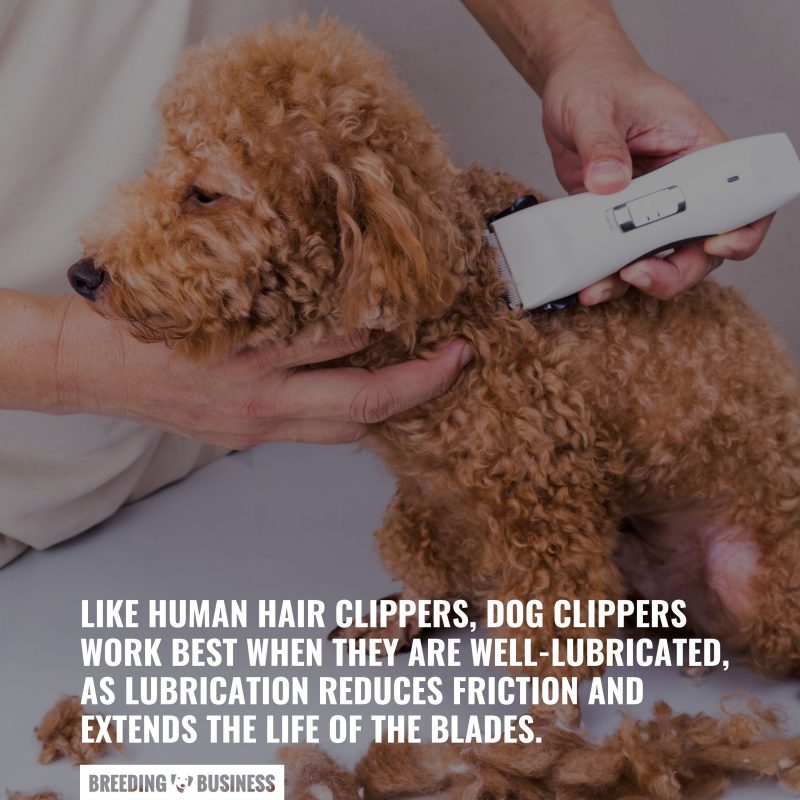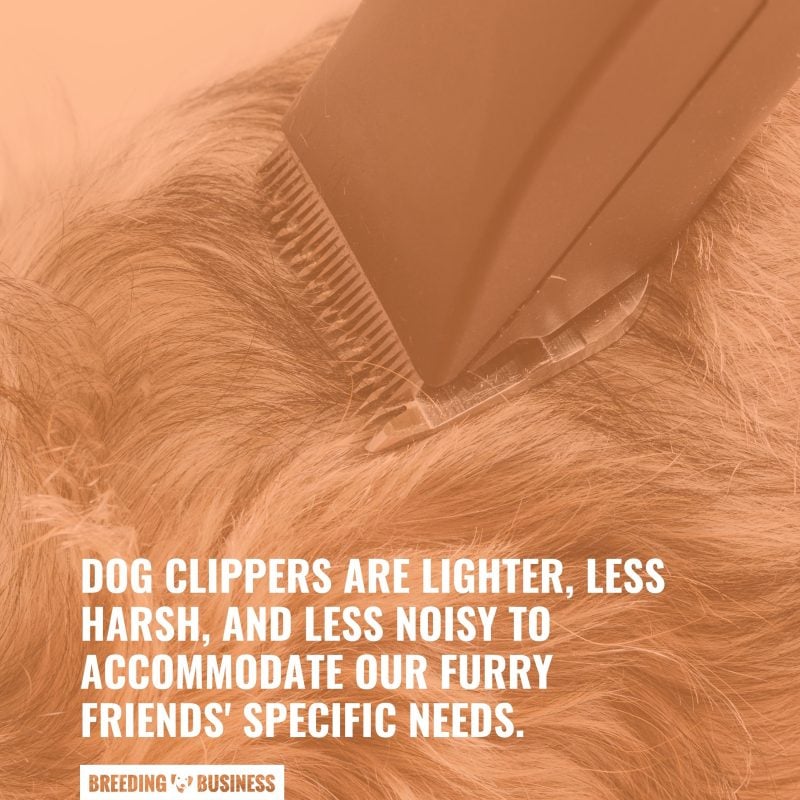Oiling dog clippers is an essential but often overlooked part of dog grooming. Your dog clippers work best when there is not much friction between the blades, and oiling not only reduces friction but extends the life of your trusty clippers.
Dog clipper oil helps your clippers to do their job and do it well. If you want to give your dog the best haircut, you need to take the best care of your clippers! Your dog clippers accommodate the different types of hair and different thicknesses, so it’s important that they’re able to do their job well.
Without maintenance, dog clippers may become inefficient, snagging on hair and potentially cutting the skin in the process. To find out more about oiling dog clippers, read on with us today!
How To Properly Maintain and Oil Clippers
Like human hair clippers, dog clippers work best when they have lubrication, as lubrication reduces friction and extends the life of the blades. There are four points on the clipper blade to oil. Also, you should oil your blades every 20 minutes and between cuts.
The less friction on the blades, the easier the cut is for your dog. Overall, if you take good care of your dog clippers, they’ll do the best job for you. The rest is down to your skill!
Oiling Your Clippers
You should only use blade oil for oiling dog clippers. Do not turn to other forms of lubrication like spray coolants or WD-40. These products evaporate quickly, cause more friction, and heat, and can destroy the cutting edges of the blades.
In contrast, blade oil stays on the blade to reduce friction, and heat, and to stop pet dander from sticking. The aforementioned products can also cause health problems. Many of them contain denatured alcohol which can be toxic if breathed in. Oil, on the other hand, is completely safe.
To begin, push the cutter out to either side so that the clipper spring lines up with the notch in the cutter. You should be able to see the rear rail on both sides of the spring, giving you access to the first three points. Put one small drop of oil on both rear rails.
The first drop should go on the rear rail outside the left spring. The other drop should go outside the right spring. The third small drop goes in the groove at the top of the cutter. If you do not oil this part once a day, the blade may cause a screeching sound and not cut correctly. A dry blade guide makes cutters hesitate and cornrow.
Then, push the cutter back into the center of the blade. The fourth drop goes on the cutter teeth. The final drop goes in the center of the blade, on the cutting surface. Do not run a bead of oil across the teeth! When you start the clippers up, the oil will spread by itself in a thin coating across the blade.
Just be sure to check the blades for damage before using them!
Washing Your Clippers
Blade wash is essential for maintaining your dog’s clipper blades. It is especially important if you intend to groom multiple dogs, as cross-contamination is a possibility. When using a blade wash, always follow the manufacturer’s instructions closely. Washing cordless dog clippers are so much easier.
Most blade washes, though, require you to submerge the clipper blades in the wash for 10 to 15 minutes, and then pat try. Some manufacturers require you to submerge only the clipper blade into the wash and to run the clipper for five to eight seconds. After this, you can use blade oil if you need to.
Removing Hair
There are plenty more things you can do to extend the life of your dog clippers and to get the best cuts out of them. First, make sure that your clippers are clean every day. This means removing all the hair from the blades.
By allowing hair to build up, it can travel down inside the clipper, stopping the mechanism from working properly. Using a blade wash can also help to get rid of stubborn hairs and dirt from your clipper blades. Some groomers will use toothbrushes or toothpicks to remove hard-to-budge hairs.
Sharpening Your Blades
If your blades start to grab and pull the coat or appear misaligned, it’s possible that the blades are dull and dog clippers need sharpening. It’s best to consult with the manufacturer of the clippers to see if there are any service centers available.
While it is possible to sharpen blades yourself, doing it poorly can lead to problems for your dog and your clippers. Poorly-sharpened blades have less of a lifespan and could injure your dog. If in doubt, always keep spare blades on hand to replace your current ones. This will allow you to carry on working even if you spot problems with your current blades.
Check For Damage
Dog clippers with damage or any kind of cable issues can harm you and your dog. Whether it be through an electric shock or a nick to the skin, you should not use clippers that have damage as they are dangerous.
Always check your clippers for problems before you use them to prevent harm. And, it pays to have a spare set of clippers on hand in case your current ones stop working or become damaged. Do not use the clippers if you have any doubts about their integrity.

Oiling Dog Clippers: FAQ
Have any more questions or concerns about oiling dog clippers? Feel free to check out our Frequently Asked Questions section for more details. If in doubt about your dog’s grooming needs, always ask your vet and local dog groomer for more advice!
Your dog clipper blades should be cleaned after every clipping session. By regularly cleaning your clipper blades, you can extend the life and efficiency of your clippers. Removing built-up hairs stops blockages in the blades, whilst oiling reduces the friction between the blades.
Be sure to clean your blades thoroughly. This means taking them out, removing all the debris, and checking the entire clipper for signs of damage and dirt.
Generally speaking, it’s best to give your dog a bath before their haircut. However, it’s important to dry them thoroughly before you clip their coat. You should avoid clipping a dirty dog wherever possible, as dirt and dead hairs can clog the clippers and make them less effective.
Each dog is different, and some may enjoy thorough grooming. Most dogs seem to appreciate having the tangles and heaviness taken out of their coats, adding a spring to their step. Not only this, but regular grooming is essential for maintaining your dog’s health and wellbeing. Without regular grooming and a suitable bathing schedule, your dog may suffer from dry skin, hair loss, and many other preventable issues.
However, it’s important to remember that our own reactions are a huge influence over our dogs and how they feel. As a dog owner, you know that dogs have a keen sense when it comes to your emotions. If you are used to your dog looking a certain way, and they come home from the groomer’s looking different than you expected, your disappointment and anger will be detected by your dog.
This can cause anxiety and confusion for your dog, as they do not understand why you are upset with them. If you react positively to their experience, your dog is more likely to “feel better” after their grooming and will be more accepting of the process next time.
It’s a good idea to sharpen or replace your clipper blades every four to six months, or as needed. It also pays to change the blade drive (drive lever) of your clippers. If this part of your clippers gets worn down, it can produce tram lines, snagging, and give the appearance of a dull blade.
You should also keep a spare set of clippers on hand in case you need them. Even the best of groomers run into problems with clippers, such as them suddenly not working in the middle of a groom. Think ahead and prepare for that situation!
If your dog is likely to be aggressive at the groomer’s, always be upfront and honest. This is important not only for your dog’s comfort and safety but for the safety of everyone at the grooming salon. Aggressive dogs can be challenging to groom, but some precautions will help to minimize the risks. One of the most common practices is to use a loop on the grooming table.
There are usually two loops, one around the neck, and the other under the hind legs. Working on a dog who keeps moving around is dangerous for both the groomer and the dog, so having this restraint can do wonders. Other devices that groomers might use include muzzles and long-handled grooming tools.
What and Why are Dog Clippers Used
Dog clippers are specialized implements used to cut dog hair. Dog clippers can be used at home to make grooming easier. They work on the same principle as scissors but are distinct from scissors and razors. In contrast to scissors, clippers are made up of a pair of sharp, comb-like blades that are in close contact with each other.
The blades slide sideways relative to each other, a mechanism that can be either manual or electrical. The clipper is moved by the user so that the hair is positioned between the teeth of the comb, and the blades cut with a scissor action when they slide sideways. To achieve this cut, friction between the blades must be as low as possible, which is where oiling comes in.
At a glance, human and dog hair clippers might look very similar. However, there are some key differences. Firstly, the blades of human clippers have teeth that are closer together. This means that dog hair can quickly jam human clipper blades, meaning that you may need to spend more money replacing them.
Thick-coated breeds are much more likely to break a pair of human hair clippers. Secondly, many dog clippers are made with a lighter motor so that the noise is quieter for your dog. The loud sounds that a human clipper makes can stress out a nervous dog, leading to sudden movements that can end in injury for your pooch.
Overall, dog clippers are:
- less harsh
- less noisy
- lighter

How Often Should I Groom My Dog
The number of times you will need to groom your dog and give them a haircut will vary depending on several factors. Generally speaking, dogs with short, smooth coats should have at least once a week grooming to remove dead and loose hair.
For dogs with medium-long or double coats, brushing two to three times per week is good to remove dirt, loose hair, and dead hair. For long-haired breeds like Afghan Hounds, daily brushing is important to maintain the coat and prevent matting.
When it comes to hair cuts, the best frequency again varies from dog to dog. For example, Labradoodles should get a hair cut at the groomer’s every 6 to 8 weeks to prevent matting. Similarly, the Lhasa Apso benefits from hair cuts every 6 weeks.
In contrast, a Labrador Retriever does not need to get a hair cut at the groomer’s, as it is largely unnecessary for them. Speak to your local groomer about your dog’s specific needs and plan a schedule with them.
To recap, you should be oiling your dog clippers between every grooming session. There are four points to oil on the clipper to get the best out of your blades. It’s also important to wash and clean your blades to remove hair and dirt. Be sure to wash and dry your blades, too, to remove hair and dander from them.
